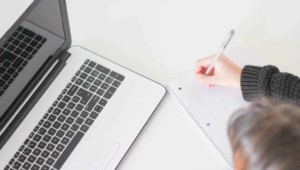Teacher Reflections on Practicing Student-Driven Formative Assessment

By Barbara Jones
Tulsa Public Schools teacher Jennifer Lowther recently told me that, “I’m a completely different learner in formative assessment right now compared to a year ago. I can’t imagine how different I’m going to be in another year.” Jennifer has been practicing formative assessment as part of the How I Know initiative, a project created in partnership with the Michael & Susan Dell Foundation in which 60 teachers from Dallas ISD, Austin ISD and Tulsa Public Schools have been developing their formative assessment practice.
While each district’s team has developed different models for teacher professional learning to support pilot teachers’ formative assessment practice, our team of WestEd coaches (who collect observational evidence about changes in practice) recently began to notice teachers from the three districts raise similar observations about the changing roles of teachers and students that have emerged as a result of their use of formative assessment.
We observed that one of the most critical moments for teachers learning formative assessment is when they have a mindset shift about the potential for the student role in learning. It is when a teacher realizes students have the capacity to gauge where they are in their own learning, to set their own goals for next steps, and to help their peers tackle learning challenges. We interviewed three teachers, one from each district, to learn more about their journey, and explore their reflections about these changes to the teacher and student roles. Below, we share what they view as primary outcomes, challenges, and strategies for encouraging this shift.
What the Change in Student Role Looks Like
All three teachers we interviewed described shifts in their mindsets as they gained experience in formative assessment. Jennifer Lowther, a teacher from Will Rogers Junior High School in Tulsa put it like this:
We talk a lot about our mindset shift, and … I call it a philosophy, like a classroom philosophy. You really have to change it and shift it, and that kind of collectively happened for us in December. So I feel like we’ve really been diving in for the last four months.
Another How I Know teacher, Esmeralda Hernandez, who teaches 3rd/4th grade bilingual math and science at Ben Milam Elementary School in Dallas, shared how a change in the student role in her classroom has helped students experience their own mindset shifts, enabling them to take ownership of their learning:
I noticed that the students are more positive and they want to learn, and math has become an area of strength for all of them. It’s just been very powerful, to see that they own their learning, and that they can all achieve. Because that is the shift in the mindset that they can all achieve, because maybe before they would think “Oh, I’m not good at this.”

We also heard from teachers that this mindset shift does not necessarily happen all at once, but can come slowly. For example, they may see first that students are more competent than they expected at using success criteria to evaluate their learning status. Then, later on, they may glean that students can also participate in co-creating the learning goals and success criteria, as well as participate in decisions about how to move learning forward. As Esmeralda mentioned, students may also begin to develop positive learner identities as a result of these shifts. Kevin Rawlings, who teaches 7th grade English Language Arts at Bailey Middle School in Austin shared his evolving understanding of formative assessment in this way:
[In the past] when I would hear the term formative assessment, I would think of it as, essentially, what I now think of as an evidence gathering tool. Where it was just something that’s “one and done” that you just use in the classroom. But now I’ve since learned that formative assessment is a much broader thing–it’s an overall ethos and it’s something you apply in your classroom that isn’t just … a single tool. Rather, it’s a different approach to teaching. It’s more of something that is ongoing, and it involves more student-led activities rather than just being teacher-centric.
However, making this transition is not without its roadblocks.
The Challenges Facing the Transition
Sometimes, even with an evolving understanding, teachers may struggle with applying a more student-centered model in their own classrooms. Teachers shared that they sometimes feared that their classrooms could become too chaotic, that they could lose control and never get it back. Yet as these teachers gained more experience, they also said that they could begin to see a path forward, and while it could get messy, and many wrong turns could be taken, the benefit of shifting the roles in the classroom so that students have more say, more agency, and more buy-in, are invaluable. Jennifer explained that, “I feel like my expectations of them are changing, so how I define the student role is changing.” This perspective also leaves open the possibility for future change as her expectations of students continue to evolve.
It is, to be honest, still usually a long journey to realize the vision of students as equal stakeholders, even after deciding it’s necessary. Teachers rarely have models to show them the way forward. Many teachers who see the benefit of sharing responsibility of learning with students don’t always believe it is possible with their students or their grade level.
Teachers in the How I Know project are no exception. Kevin shared with us how he started his formative assessment journey by increasing the amount of independent group work students engage in and reducing the amount of lecturing he does. He says, though, that much of his attention during lessons is still focused on containing the energy and volume of the classroom. His sense is that his 7th graders are continuously pressing against the classroom order and his ability to keep control is important for learning to occur. “The reality of it is sometimes if you just take the reins off in a seventh-grade classroom like that, it can get into some pretty off-task behavior.” Kevin is currently in the process of integrating peer feedback into his lessons and developing more structures that involve focus on student learning within collaborative structures, such as mock debate and student creation of learning posters. These structures support extended discourse and rich academic discussions in which students learn together.
Using Transparency as a Strategy for Moving Forward
Though challenging, however, these teachers talked about learning from, and wanting to continue, making this shift in the student role. Jennifer, who also teaches middle school, decided to take the plunge. She shared that she believes in the importance of increasing the student role in learning through formative assessment, and sees the value in engaging students more as partners in the learning process. Once she understood the mindset change needed, she decided to engage her students by becoming completely transparent with them about her own learning, as well as theirs. Here’s what she said about starting with a new group of students last January:
A lot of what was different at that point was what I was telling students. I was telling them what I was working on and where I was and the team that I was a part of. I was very transparent about my goals for myself for the next three or four months and what I wanted to get out of my time with them. And then we started talking about what I hoped they got out of that time. But I started the conversation being very transparent. I promised, you can learn from me, but I’m working on all of these things.
And I was also really honest about what I wanted them to hold me accountable for. I said, “One of my goals is that we have a learning goal and success criteria every day that you understand and that you can use.” And there have been days where I’ve been sick the day before, and I show up, and I don’t really know what’s going on, and they want to know where their learning goal is. And I say, “Hold me accountable.” Because that was my goal for myself. So that was a huge difference for them. And I think I can tell it was different for them to hear their teacher talking to them about what they were wanting to learn and what I was wanting to learn. So that immediately affected our dynamics.

With this approach, Jennifer positioned herself as a learner and the students as important supporters of her learning. She also modeled that it is okay for them to share where they are in their own learning and to identify as beginners. This sets up a powerful model and helps establish a trusting and more equitable classroom culture. Her next step in her effort to shift the student role was to help students create their own learning goals:
Then we took some time for them to create some of their own goals. Which I do a lot, but I also made the step of what’s your success criteria for that? To help them go through the process of making one of these and what it feels like. And we refer back to those. For example, I ask, ‘How is this helping you get to your second success criteria?’
Esmeralda also shared how she works to increase the capacity of students to drive their own learning. She said that, “My students have learned to identify their needs and create a path to get to their goals.” When asked about what scaffolds and supports she provides students as they use formative assessment, she stated, “A lot of modeling and sitting with them and going over the work.” Just like Jennifer, Esmeralda also relies on transparency as an important strategy in her formative assessment practice. For her, transparency comes in the form of think out louds while she is modeling:
It’s a lot of me thinking out loud for them at the beginning. I have to say, ‘Okay so this is what I’m thinking.’ ‘Oh, I struggle with these things too.’ So giving them examples of how I struggle myself and how they can correct me shows them how everybody makes mistakes, and that it’s okay because this is how we learn.
Closing Thoughts
Each of these three teachers highlight important issues as well as solutions for implementing formative assessment. Jennifer hit on a final important strategy when she said:
Something that I underestimated in formative assessment is how much I really need to know about each of my students. Because you’re asking them to do things that are harder… Or [work in] a situation that is uncomfortable for them, even if the tasks aren’t any harder. Because you’re really putting that responsibility of learning on them.
What Jennifer is getting at is that when teachers know their students well, they are better equipped to accurately interpret the evidence of learning students share with them. These teacher voices also hint at a two-way transparency that develops in formative assessment, where there is a new “honesty” about what each person in the classroom knows, including the teacher and the students. This enables the development of a supportive classroom culture where individuals aren’t afraid to show what they know and ask for help. This also creates more and better evidence of student learning.
As these teachers have shared with us, it is the daily practices of providing transparency about learning and ongoing modeling and support that enable them and their students to make the shift towards greater shared responsibility for learning. With these daily practices, students gain more confidence and knowledge to manage their own learning, and the teacher continues to develop new routines, structures, and activities through which students can do the learning. When they’ve made the shift, the pay off is not only that students learn more, but they learn how to learn, gaining skills that don’t fade over time, but instead strengthen as they continue to create their own learning pathways.
For more, see:
- How Formative Assessment Transforms the Classroom, From Culture to Lesson Plans
- How I know: Impacting the Classroom through Student-Driven Learning in Dallas
- Keys to Success for Formative Assessment: A Professional Learning Guide
Barbara Jones is a Senior Professional Learning Specialist at WestEd. Connect with her at [email protected].
This post is a part of a series focused on the “How I Know: Designing Meaningful Formative Assessment” initiative sponsored by the Michael & Susan Dell Foundation. Check out the How I Know website (www.formativeassessmentpractice.org) and join the conversation on Twitter using #HowIKnow or #FormativeAssessment.
Stay in-the-know with innovations in learning by signing up for the weekly Smart Update. This post includes mentions of a Getting Smart partner. For a full list of partners, affiliate organizations and all other disclosures, please see our Partner page.




John Smith
Nice post. Thanks for sharing.